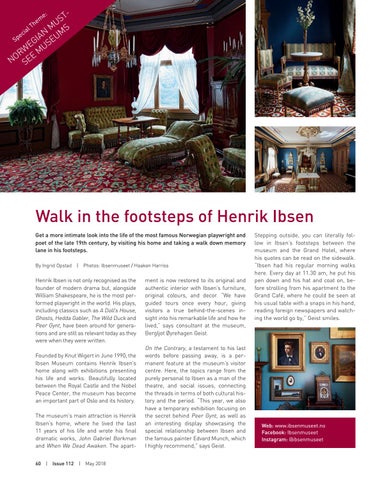TS U lT M S a i N M ec IA EU Sp G E US W R EM O N SE e:
m he
Walk in the footsteps of Henrik Ibsen Get a more intimate look into the life of the most famous Norwegian playwright and poet of the late 19th century, by visiting his home and taking a walk down memory lane in his footsteps. By Ingrid Opstad | Photos: Ibsenmuseet / Haakon Harriss
Henrik Ibsen is not only recognised as the founder of modern drama but, alongside William Shakespeare, he is the most performed playwright in the world. His plays, including classics such as A Doll’s House, Ghosts, Hedda Gabler, The Wild Duck and Peer Gynt, have been around for generations and are still as relevant today as they were when they were written. Founded by Knut Wigert in June 1990, the Ibsen Museum contains Henrik Ibsen’s home along with exhibitions presenting his life and works. Beautifully located between the Royal Castle and the Nobel Peace Center, the museum has become an important part of Oslo and its history. The museum’s main attraction is Henrik Ibsen’s home, where he lived the last 11 years of his life and wrote his final dramatic works, John Gabriel Borkman and When We Dead Awaken. The apart60 | Issue 112 | May 2018
ment is now restored to its original and authentic interior with Ibsen’s furniture, original colours, and decor. “We have guided tours once every hour, giving visitors a true behind-the-scenes insight into his remarkable life and how he lived,” says consultant at the museum, Bergljot Øyrehagen Geist.
On the Contrary, a testament to his last words before passing away, is a permanent feature at the museum’s visitor centre. Here, the topics range from the purely personal to Ibsen as a man of the theatre, and social issues, connecting the threads in terms of both cultural history and the period. “This year, we also have a temporary exhibition focusing on the secret behind Peer Gynt, as well as an interesting display showcasing the special relationship between Ibsen and the famous painter Edvard Munch, which I highly recommend,” says Geist.
Stepping outside, you can literally follow in Ibsen’s footsteps between the museum and the Grand Hotel, where his quotes can be read on the sidewalk. “Ibsen had his regular morning walks here. Every day at 11.30 am, he put his pen down and his hat and coat on, before strolling from his apartment to the Grand Café, where he could be seen at his usual table with a snaps in his hand, reading foreign newspapers and watching the world go by,” Geist smiles.
Web: www.ibsenmuseet.no Facebook: Ibsenmuseet Instagram: @ibsenmuseet
